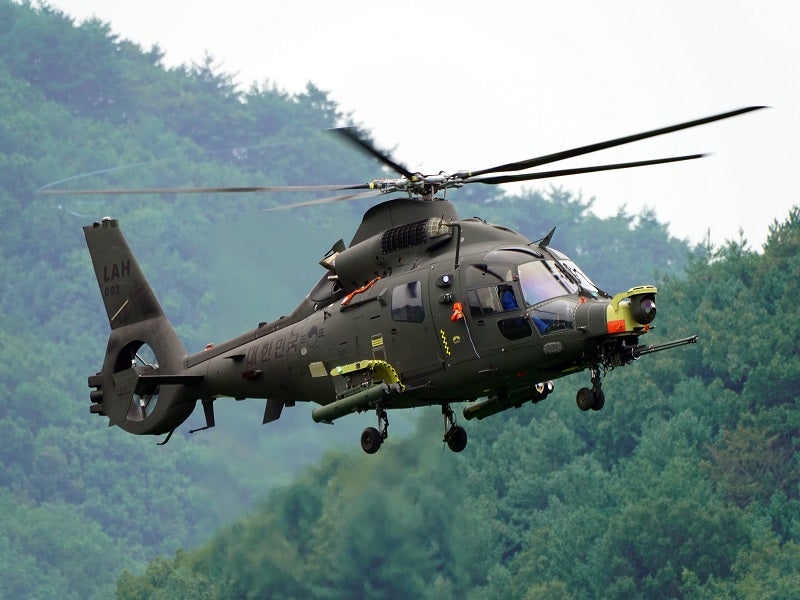The KAI Light Armed Helicopter (LAH) is being developed by Korea Aerospace Industries (KAI) for the Republic of Korea Army (RoKA). It can be deployed in multiple missions such as light attack, close-air support, escort, and troop transport. The KAI LAH is an advanced armed helicopter suitable for facing the challenges in the modern battlefield.
The helicopter performed its maiden flight in July 2019. The RoKA is expected to acquire up to 200 LAHs to replace the ageing fleet of Bell AH-1 Cobra and MD 500 Defender helicopters. The first LAH is scheduled to enter service with the RoKA by 2023.
KAI light armed helicopter development details
KAI was preferred by the Defense Acquisition Program Administration (DAPA) of South Korea to develop the light-armed helicopter in July 2014.
The company selected the Airbus H155 helicopter as the base platform for the LAH and the Light Civil Helicopter (LCH) programmes in March 2015. KAI and Airbus signed a memorandum of understanding (MoU) for the joint marketing and after-sales support for both the helicopters.
KAI began the design phase of the LAH in June 2015 and had completed the basic design by August 2016. The critical design review (CDR) of the LAH was concluded in November 2017. The first LAH prototype was unveiled in December 2018.
KAI completed the first engine run ground test of the helicopter in April 2019. The development of the helicopter is scheduled for completion in November 2022.
KAI LAH design and features
The fuselage of the South Korean LAH is made of corrosion-resistant composite materials and light alloys. The helicopter uses Airbus’ advanced rotor technology, reducing vibration and acoustic signatures. It is fitted with Spheriflex main rotor head, which ensures a smooth ride along with superior handling and in-flight stability while flying at higher speeds.
The tail boom is installed with the Fenestron tail rotor, which offers reduced noise signature, while enhancing safety during low-flying manoeuvres, especially in restricted areas. The helicopter also features upwards-directed exhausts for minimising its infrared (IR) signature.
KAI LAH’s rotorcraft has a length of 14.3m, height of 4.3m, and a rotor diameter of 12.6m. The maximum take-off weight of the LAH is 4.9t. The helicopter is fitted with a tri-cycle landing gear integrating a two-wheel nose unit and two single-wheel main units under the fuselage. The helicopter can travel at a maximum speed of 242.61km/h.
Avionics
KAI LAH features a full-glass cockpit and is manned by up to two crew. The cockpit is equipped with large LCD screens to provide enhanced situational awareness.
The helicopter is also fitted with a nose-mounted electro-optical/infrared (EO/IR) sensor, as well as the fuselage and tail-mounted missile warning receivers.
The LAH is equipped with a four-axis automatic flight control system (AFCS), helmet mounted display, fire control system (FCS), and anti-jamming global positioning system (GPS).
Armament The rotorcraft is armed with a chin-mounted 20mm Gatling-type gun. It also features stub wings with four hard points.
The under-wing hard points can be attached with rocket pods suitable for 70mm rockets. The helicopter can be equipped with air-to-ground missiles and non-guided rockets.
The LAH features real-time weapon aiming capability, self-protective laser, and man-portable air-defence system (MANPADS) to tackle multiple threats.
Engines
The helicopter is powered by two Arriel 2L2 turboshaft engines, which develop a maximum take-off power of 1,032shp each. The engine features a new axial compressor, new high-pressure compressor diffuser, and a new-generation dual-channel full authority digital engine control (FADEC) system.
Arriel 2L2 is the latest member of the Arriel family and is the most powerful Arriel version developed by Safran to date. It will ensure better safety, reliability, and performance during challenging missions. Safran Helicopter Engines was contracted by KAI to deliver Arriel 2L2 engines for the LAH in June 2016. Safran signed an agreement with Hanwha Techwin for the joint development and production of the engines in South Korea.
Hanwha Techwin will also perform the maintenance, repair, and overhaul (MRO) of the engines under the agreement.




